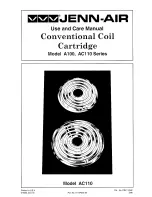
EXPANDABLE 528
D E H Y D R A T O R
Owner’s Manual User Guide
22
Vegetables
Vegetable
Preparation
Avg. Dry
Time (Hrs)
Asparagus
Remove woody end. Slice diagonally into ½”-1” pieces. Blanch/steam.
3 - 10
Green Beans
Snip off ends, pull off strings. Dry whole or slice diagonally into ½”-1”
pieces or cut lengthwise. Blanch/steam.
6 - 12
Beets
Steam until tender. Cool and peel. Cut in slices, cubes or shoestring strips.
3 - 10
Broccoli
Cut all stalks in halves or quarters. Blanch/steam.
4 - 10
Cabbage
Trim outer leaves. Cut in half. Core. Cut into strips or dry whole leaves.
Blanch/steam.
4 - 10
Carrots
Remove tops and stringy end. Peel, cut crosswise, lengthwise or
diagonally into slices, cubes or grate. Blanch/steam.
4 - 12
Caulifl ower
Cut off woody base. Separate into small fl owerets, slice or cube into
pieces. Blanch/steam.
6 - 14
Celery
Trim. Cut lengthwise or crosswise into strips or pieces. Leaves may also be
dried. Blanch/steam.
3 - 10
Corn
Remove husk and silk. Blanch/steam. Plunge immediately into cold water.
When cool, drain. Cut kernels from cob.
6 - 12
Cucumbers
Peel (skin is bitter when dried). Slice or shred. Salt, if desired.
4 - 10
Eggplants
Trim. Peel. Cut into round slices, julienne strips or cubes. Blanch/steam.
Skin may be dried separately.
4 - 14
Greens
Cut off stems. Blot dry on paper towels.
4 - 10
Mushrooms
Remove woody stems. Wipe with brush or cloth. Do not wash. Slice or
cube. Small mushrooms may be dried whole.
4 - 10
Okra
Trim off stem and tip. Slice pods into pieces or cut lengthwise.
4 - 10
Onions
Cut off stem and root. Remove outer skin cut in slices, rings or dice.
6 - 12
Peas
Sort. Blanch/steam.
5 - 14
Peppers
Remove stem and seed head. Cut in rings, strips or dice. Seeds may also
be dried. Blanch/steam. For seeds use leather sheets.
5 - 12
Potatoes
Peel. Remove green lining just under skin. Cut away bruises. Cut into
slices, strips or grate. Blanch/steam.
4 - 12
Pumpkins
Cut in half. Scrape away pulp and seeds. Remove rind. Cut into wedges 1”-3”
wide and then into strips ½” wide. Seeds can also be dried. Blanch/steam.
6 - 12
Winter Squash
(Butternut,
Acorn)
Cut in half. Remove seeds and stringy fi ber. Peel off rind. Cut into strips or
cubes. Seeds may also be dried. Blanch/steam.
4 - 10
Summer Squash
(Zucchini)
Peel if desired. Cut in slices, cube, julienne strips or coarsely grate. If larger
than 12” remove seeds and fi brous tissue. For vegetable chips soak in soy
sauce before drying.
4-10
Tomatoes
Remove stem area. Peel, if desired. Cut in slices. Blot excess moisture
before drying.
6-12
NOTE: Dry vegetables at 125°-135°. Use average times only as a general
guideline. Many variables can contribute to a large difference in drying times.
Vegetables should contain only 5% moisture and should look and feel crisp
and brittle.
23
Herbs
HERBS
Dried herbs are much more fl avorful than fresh herbs. 1 tsp dried herbs = 1
Tbsp fresh herbs. (¼ tsp dried ginger = 1 tsp fresh grated ginger; 1 tsp onion
powder = 1 medium onion;
1/8
tsp dried garlic = 1 clove garlic).
Many herbs can be harvested through the entire growing season. Two-thirds
of the plant may be cut, leaving the rest to grow. Once plants are cut, regular
cuttings will prevent them from fl owering.
Flowers, seeds, leaves and stems can all be used for seasoning. If fl owers
are used in teas, dry them whole. Remove any tough or discolored parts.
Dried herbs have an excellent shelf life. If stored under normal storage
conditions, they will keep their potency for four years or more. Dark colored
containers are best for storage. Light fades color and weakens fl avors.
Preparation:
• Select herbs just before the plant blooms. Leaves should be fully
developed, yet tender.
• Flowers should be harvested when they fi rst open and are still very fresh.
• Harvest on a sunny morning after the dew has evaporated.
• Herbs require no pretreatment.
• Wash leaves and stems lightly in cold water. Spread on absorbent towel
or shake off any visible moisture or pat dry.
• Be sure to remove any brown spots and insect debris from the leaves.
• Strip leaves from larger stems. Dry parsley and sage on the stems.
• Entire pods or seeds of chili peppers can be dried.
• Herbs can be placed on the drying trays within minutes of picking and
cleaning.
• Use either mesh insert trays or fruit leather sheets.
• Herbs will be brittle and crumble easily when dried. Some leaves will
darken in color but that does not affect fl avor.
• After drying leaves, they can be left whole, stripped from the stem,
ground in a coffee grinder or crushed. To crush rub between fi ngers, use
mortar and pestle or press through a fi ne screen.
• Store in airtight containers in a cool, dark, dry place. If moisture appears
on the inside of the container, the herbs will need further drying.
• Dried herbs can be diffi cult to distinguish from one another. Storage
containers should be labeled immediately following drying.
Suggested uses for dehydrated herbs:
Use in Italian, Mexican and Chinese dishes. Also
use in soups, stews, sauces, vegetables, salads,
cakes, cookies, meat dishes, fi sh dishes, egg
dishes and in seasoning mixes.
















































